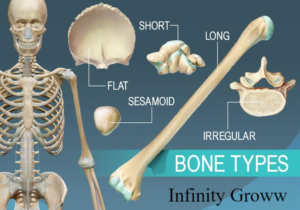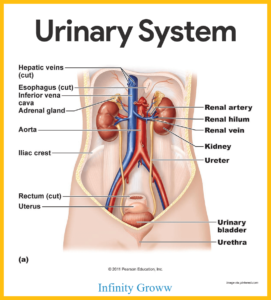The human body :
The human body enclosed with the complex system of organs, muscles, bones, veins, arteries and many more organ also but we oftenly we overlook that how these complex system is interconnected to sustain the balanced life.
It can be define as a complex system of interconnected organs, highly organized structure made up of unique cells that work together to accomplish the specific functions necessary for sustaining life.
The biology of the human body broadly classified as per below point.
- Physiology : it means how the body functions
- Anatomy : it means how the body is structured
Let’s understand the Anatomy of the human body and get brief idea about it’s function.

- Circulatory System
- Digestive System
- Endocrine System
- Immune System
- Lymphatic System
- Nervous System
- Muscular System
- Reproductive System
- Skeletal System
- Respiratory System
- Uninary System
- Integumentary System
1. Circulatory System :
The basic function of the Circulatory system is to circulate the blood throughout the body. The Crucial function of the circulatory system is to provide oxygen and nutrients to the hormones, muscles, tissues and organs throughout your body parts.
The circulatory system is sometimes called as cardiovascular system. Cardio refer for heart and vascular means to blood vessels.
Circulatory system function :
The circulatory system is help to remove waste products from the body parts. This wastes are includes:
- Breathing : Carbon dioxide from respiration
- Waste from things you eat and drink.
- Chemical byproducts from your organs.
Circulatory system Parts :

The following body parts of circulatory system are :
- Heart : a muscular organ that pumps blood throughout your body.
- Blood : made up of red and white blood cells, plasma and platelets.
- Blood vessels : which include your arteries, veins and capillaries.
The human body’s network of blood veins, vessels, and capillaries is more than 60,00 miles (nearly 96,560 kilometres) long according to the Cleveland Clinic Study.
2. Digestive System :
The digestive system of the human body comprises a group of organs working together to convert food into energy for the body. The digestive system of the human body which includes different a group of organs that work together in converting food into energy and other basic nutrients to power the body. The food we take in is digested and utilized by our body and the residue of the food are defecated.
Digestive system function :
The digestive system consists of a series of connected organs that together, allow the body to break down and absorb food, and remove waste and the digestive system produce digestive juices filled with enzymes to break down the components of your food, such as carbohydrates, fats and proteins, according to the National Institute of Diabetes and Digestive and Kidney Diseases.
Digestive system Parts :

Anatomically, The digestive system is made up of the Gastrointestinal tract which also refer as the GI tract or digestive tract.
The GI tract is a sequence of hollow organs joined in a twisting and long tube from the mouth to the anus.The GI tract follow the hollow organs series of the organs are the mouth, esophagus, stomach, small intestine, large intestine and anus. The liver, pancreas, and gallbladder are the solid organs of the digestive system.
3. Endocrine System :
Endocrine system plays a vital role in maintaining the balance of hormones in your body. It continuously monitors hormone levels in the blood to ensure proper functioning. Hormones act as messengers by binding to specific cells and transmitting their signals.
The endocrine system function :
When hormone levels increase, the pituitary gland detects this change and signals other glands to halt hormone production and release. Conversely, when hormone levels drop below a certain threshold, the pituitary gland prompts other glands to increase hormone production. This mechanism helps maintain stability in the body.
Hormones influence various physiological processes, including:
- Metabolism: Hormones regulate how the body breaks down food and obtains energy from nutrients.
- Growth and Development: Hormones play a crucial role in the growth and development of the body, particularly during childhood and adolescence.
- Emotions and Mood: Hormones can impact your emotional state and mood.
- Fertility and Sexual Function: Hormones are involved in reproductive processes and sexual function.
- Sleep: Hormones can influence sleep patterns and quality.
- Blood Pressure: Hormones play a role in regulating blood pressure levels.
The endocrine system Parts :

The endocrine system consists of various glands that produce and release hormones, targeting specific functions within the body. These glands are distributed throughout the body, including the neck, brain, and reproductive organs. While some glands are tiny, comparable in size to a grain of rice or a pea, the pancreas stands as the largest gland, measuring about 6 inches in length.
The major glands involved in hormone production are as follows:
- Hypothalamus
- Pituitary gland
- Thyroid gland
- Parathyroid glands
- Adrenal glands
- Pineal gland
- Pancreas
- Ovaries
- Testes
4. Immune system :
Your immune system is a large network of organs, WBC, proteins i.e antibodies and chemicals. To protect you from foreign invaders like, bacteria, viruses, parasites, and fungi that cause illness, infection, and disease this system works accordingly.The immune system is activated when antigens bind with receptors on immune cells, alerting the body to their presence and kicking the immune system into gear, according to Institute for Quality and Efficiency in Health Care (IQWiG).
The Immune system function
The immune system is responsible for protecting the body and maintaining overall health. It performs several functions to combat harmful germs and foreign substances:
- Recognition: The immune system can distinguish between the body’s own cells and foreign invaders.
- Activation: When the immune system detects an invader, it activates an immune response to combat it.
- Mobilization: Immune cells and molecules are mobilized and directed toward the site of infection or invasion.
- Attack: Immune cells, such as white blood cells, attack and destroy the invading germs or foreign substances.
- Antibody Production: After exposure to a specific germ, the immune system develops antibodies that recognize and neutralize that particular germ.
- Immune Memory: The immune system retains a memory of previously encountered germs, enabling a faster and more effective response upon re-exposure.
The Immune system Parts
These following parts play essential roles in the immune system’s function and defense mechanisms to keep the body protected from harmful germs and maintain overall health.

- White blood cells
- Lymph nodes
- Spleen
- Tonsils and adenoids
- Thymus
- Bone marrow
- Skin and mucous membranes
- Stomach and bowel
5. Lymphatic system :
The lymphatic system includes lymph nodes, lymph ducts and lymph vessels, and also plays a role in the body’s defenses. The lymphatic system also removes excess lymph fluid from bodily tissues, and returns it to the blood. Its main job is to make and move lymph, a clear fluid that contains white blood cells, which help the body fight infection, according to the Cleveland Clinic.
The lymphatic system function
- The lymphatic system is a network of tissues, vessels, and organs that move lymph, a watery fluid, back into the bloodstream.
- Approximately 20 liters of plasma flow through arteries and capillaries each day, with about 17 liters returned to circulation through veins, and the remaining 3 liters seeping into tissues as lymph.
- The lymphatic system collects this excess lymph and returns it to the bloodstream.
Fluid Balance and Absorption of Fats
- The lymphatic system maintains fluid levels by collecting excess fluid that drains from cells and tissues, returning it to the bloodstream.
- It also absorbs fats from the digestive tract and transports them back to the bloodstream.
Immune Function
- The lymphatic system is an integral part of the immune system.
- It produces and releases lymphocytes (white blood cells) and other immune cells.
- These immune cells monitor the body for foreign invaders, such as bacteria, viruses, parasites, and fungi.
- They destroy these invaders to protect the body from infections and diseases.
Waste Removal
- The lymphatic system transports and removes waste products and abnormal cells from the lymph.

The lymphatic system Parts
The lymphatic system includes many parts as mentioned below.
- Lymph
- Lymph nodes
- Lymphatic vessels
- Collecting ducts (right lymphatic duct and thoracic duct)
- Spleen
- Thymus
- Peyer’s patches
- Adenoids
- Bone marrow
- Appendix
- Tonsils
6. Nervous system :
The nervous system is a complex network of nerves that controls and coordinates various functions of the body. It plays a crucial role in our thoughts, movements, senses, emotions, and overall well-being. It allows us to interact with our environment and regulates vital processes such as heartbeat, breathing, digestion, and sleep.
The nervous system functions as a command center, receiving and interpreting information from the surroundings and facilitating appropriate responses. Through its extensive network of nerves, it enables communication between cells, glands, and muscles throughout the body. According to the National Institute of Child Health and Human Development the central nervous system connects the peripheral nervous system the every other part of the body.

- Somatic nervous system
- Peripheral nervous system
- Central nervous system (CNS)
- Autonomic nervous system
7. Muscular system :
The body’s muscular system consists of about 650 muscles that aid in movement, blood flow and other bodily functions, according to the Library of Congress. There are three types of muscle: skeletal muscle which is connected to bone and helps with voluntary movement, smooth muscle which is found inside organs and helps to move substances through organs, and cardiac muscle which is found in the heart and helps pump blood.
- Muscles are soft tissues composed of stretchy fibers.
- There are over 600 muscles in the body.
- Different types of muscles have specific functions.
- Muscles enable movement, ranging from running and jumping to delicate tasks.
- The heart is a hard-working muscle responsible for pumping blood throughout the body.
- Some muscles are involved in essential processes like breathing and digestion.
- Disorders, injuries, and diseases can affect muscle function.
- Muscle-related issues may include pain, spasms, weakness, or paralysis.
- Maintaining a healthy lifestyle is important for optimal muscle function.
- Heart diseases, such as cardiomyopathy, can impair the heart’s pumping ability.
- Keeping muscles strong involves maintaining a healthy weight, balanced diet, and regular exercise.
- Regular check-ups with healthcare providers help identify and address muscle-related problems.
8. Reproductive system :
The reproductive system enables humans to reproduce. In males, the reproductive system comprises the penis and testes, responsible for sperm production. Females have the vagina, uterus, and ovaries as part of their reproductive system, with the ovaries producing eggs. Conception occurs when a sperm cell combines with an egg cell, resulting in a fertilized egg that implants and develops within the uterus.
Reproduction in Human Beings
- Human reproduction involves sexual reproduction, where two parents contribute to the creation of a new individual.
- Offspring are formed through the fusion of gametes (sex cells) from each parent.
- This process results in offspring that are genetically and physically distinct from their parents.
Human Reproductive System
- Humans exhibit sexual dimorphism, meaning that males and females have distinct reproductive systems.
- Males possess testes, commonly known as testicles, which are responsible for sperm production.
- Females have a pair of ovaries, which produce eggs (ova) and secrete the female hormone estrogen.
Male Reproductive System
The male gametes, i.e., sperms are produced within the male reproductive system. Sperms are small unicellular structures with a head, middle piece, and a tail.
The male reproductive system consists of :
- Testicles (testes)
- Scrotum
- Vas deferens
- Accessory glands
- Penis
Female Reproductive System
The female reproductive system is active before, during and after fertilization as well. It consists of the following parts:
- A pair of ovaries
- Fallopian tubes (Oviducts)
- Uterus
- Vagina
9. Skeletal system :
The musculoskeletal system, commonly known as the skeletal system, serves as the central framework of the human body. Comprising bones and various connective tissues such as cartilage, tendons, and ligaments, it provides structural support and facilitates movement.The human body’s skeletal system includes 206 and 213 bones in an adult human body, which are all connected by tendons, ligaments and cartilage, according to the journal StatPearls.

During infancy, the human body possesses approximately 270 bones, which subsequently fuse together as growth progresses. Apart from enabling movement, the skeletal system plays crucial roles in blood cell production and calcium storage. It is worth noting that while teeth are integral to the skeletal system, they are distinct from bones in classification.
Each bone consist three main layers:
- Periosteum
- Compact bone
- Spongy bone
The other parts of skeletal system as mentioned below
- Cartilage
- Joints
- Immovable joints
- Partly movable joints
- Movable joints
- LigamentsTendons
10. Respiratory system :
The respiratory system performs a variety of functions in addition to facilitating inhalation and exhalation. It enables communication through speech and enables the sense of smell.
Furthermore, it warms incoming air to match body temperature and humidifies it to the necessary humidity level. The respiratory system also plays a crucial role in delivering oxygen to the body’s cells and eliminating waste gases, notably carbon dioxide, during exhalation. Additionally, it serves as a protective mechanism for the airways, safeguarding them against harmful substances and irritants.

The respiratory system comprises various parts that work collaboratively to facilitate breathing. These parts can be categorized into different groups:
- Airways:
- Mouth and nose: Openings that intake air from the external environment into the respiratory system.
- Sinuses: Hollow areas in the head bones that regulate the temperature and humidity of inhaled air.
- Pharynx (throat): Tube that transports air from the mouth and nose to the trachea.
- Trachea: Passage connecting the throat and lungs.
- Bronchial tubes: Tubes branching out from the trachea and entering each lung.
- Lungs:
- Lungs: Two organs responsible for extracting oxygen from the air and transferring it into the bloodstream.
- Muscles and Bones:
- Diaphragm: Muscle aiding the inhalation and exhalation process by assisting the lungs in pulling in and pushing out air.
- Ribs: Bones that surround and protect the lungs and heart.
- Gas Exchange and Blood Vessels:
- Alveoli: Tiny air sacs within the lungs where the exchange of oxygen and carbon dioxide occurs.
- Bronchioles: Small branches of the bronchial tubes that lead to the alveoli.
- Capillaries: Blood vessels within the alveoli walls that facilitate the movement of oxygen and carbon dioxide.
- Lung Structure:
- Lung lobes: Sections of the lungs (three lobes in the right lung and two in the left lung).
- Pleura: Thin sacs enveloping each lung lobe, separating them from the chest wall.
- Additional Components:
- Cilia: Tiny hairs in the airways that move in a wave-like motion, filtering out dust and other irritants.
- Epiglottis: Flap of tissue at the entrance to the trachea, preventing food and liquids from entering the airway during swallowing.
- Larynx (voice box): Hollow organ enabling speech and sound production when air moves in and out.
11. Urinary system :
The urinary system, also known as the urinary tract, functions as the body’s filtration system by eliminating toxins and waste through urine. It involves a series of organs, ducts, and tubes that facilitate the passage of waste. Any disruptions in this process can affect normal urination.
The main components of the urinary system include:
- Kidneys:
- Two kidneys: These organs filter waste and excess substances from the blood to produce urine.
- Ureters:
- Two ureters: Ducts that connect the kidneys to the bladder, enabling the transport of urine.
- Bladder:
- Bladder: An organ that serves as a reservoir for urine storage until it is eliminated from the body.
- Urethra:
- Urethra: A tube connected to the bladder, allowing urine to exit the body during urination.
Together, these organs and structures work in coordination to ensure the removal of waste materials from the body through the urinary system.
12. Integumentary system :
The integumentary system is the outer layer of the body, consisting of the skin, nails, hair, and associated glands and nerves. It serves as a physical barrier, protecting the body against bacteria, infections, injuries, and sunlight. Additionally, it helps regulate body temperature and enables the perception of sensations such as hot and cold on the skin.
The integumentary system is composed of several main structures:
- Skin:
- Epidermis: The top layer of the skin that provides a waterproof barrier and contains melanocytes (cells responsible for skin color), keratinocytes, and Langerhans cells.
- Dermis: The middle layer of the skin, thicker than the epidermis, containing sweat glands, oil glands, and hair follicles.
- Hypodermis: The bottom layer of the skin, consisting of fatty tissue that aids in insulation.
- Nails:
- Nail plate: The visible hard part of the nail.
- Nail bed: The skin beneath the nail plate.
- Cuticle: The thin skin at the base of the nail plate.
- Matrix: The root of the nail responsible for nail growth.
- Lunula: The whitish, crescent-shaped area at the base of the nail plate.
- Hair:
- Hair shaft: The visible and stylable part of the hair.
- Hair follicle: The tube-like structure that anchors the hair in the skin.
- Hair bulb: Located under the skin, responsible for hair growth.
- Glands:
- Sudoriferous glands: Sweat glands that release sweat onto the skin’s surface, including eccrine glands (found throughout the body) and apocrine glands (connected to hair follicles).
- Sebaceous glands: Glands that produce sebum (oil) and contribute to facial oil.
- Ceruminous glands: Glands in the ear canal that secrete earwax.
- Mammary glands: Glands on the chest that produce milk in individuals assigned female at birth (AFAB) after giving birth.
The integumentary system plays a crucial role in protecting the body, regulating temperature, and facilitating sensory experiences through its various structures and functions.







